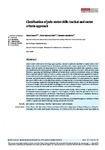Mostrar o rexistro simple do ítem
Classification of judo motor skills: tactical and motor criteria approach
| dc.contributor.author | Carballeira, Eduardo | |
| dc.contributor.author | Dopico-Calvo, Xurxo | |
| dc.contributor.author | Iglesias-Soler, Eliseo | |
| dc.date.accessioned | 2024-04-08T13:59:30Z | |
| dc.date.available | 2024-04-08T13:59:30Z | |
| dc.date.issued | 2014-12-29 | |
| dc.identifier.issn | 2300-8822 | |
| dc.identifier.uri | http://hdl.handle.net/2183/36091 | |
| dc.description.abstract | [Abstract]: The so-called combat sports involving a grip in general, and judo in particular, represent a complex reality of dis-ciplines with common structural features. Such sports, particulary judo, require a great number of skills and tech¬niques, which are used for sporting objectives; to facilitate understanding and simplify their organization, numer¬ous classifications have been proposed. Studying a sport through the analysis of its motor skills involves, in the first place, organizing and classifying its different movements based on relevant and pertinent criteria, and relating them to the main objective. This work aims to present a proposal for the classification and organization of specif¬ic judo skills, based on the establishment of motor and tactical criteria, to analyse and optimize learnig and training processes, and applied research, enabling a new perspective on sporting analysis. Our main intention is to organize judo motor skills in order to: a) facilitate the acquisition of a large amount of movements (techniques) and to design a tool for acquiring a significative learning through a classificaction based on motor criteria; b) use this proposal as a resource to design, control and optimize the training process; and c) analyse the sport of judo from a tactical per¬spective by studying the relationship between the different components of the struggle. Criteria used for classification were: a) Movement structure (with turning, without turning or supine position), b) Sustentation base (one support, two supports or back support), c) Space where the opponent is thrown (for¬ward throw or backward throw), d) Direction of the dynamic leg (ipsilateral direction or contralateral direction), and e) Spatial zone of the dynamic leg (inner zone or external zone). Nine groups of specific judo tecniques, with common motor features, are presented through the combination of these criteria to organize and optimize learning, training and analysis of the bout. | es_ES |
| dc.language.iso | eng | es_ES |
| dc.publisher | Archives of Budo | es_ES |
| dc.relation.uri | https://smaes.archbudo.com/view/abstract/id/10737 | es_ES |
| dc.rights | Atribución-NoComercial 4.0 España | es_ES |
| dc.rights.uri | http://creativecommons.org/licenses/by-nc/3.0/es/ | * |
| dc.subject | Judo analysis | es_ES |
| dc.subject | Judo learning | es_ES |
| dc.subject | Laterality | es_ES |
| dc.subject | Fight structure | es_ES |
| dc.subject | Judo techniques | es_ES |
| dc.title | Classification of judo motor skills: tactical and motor criteria approach | es_ES |
| dc.type | info:eu-repo/semantics/article | es_ES |
| dc.rights.access | info:eu-repo/semantics/openAccess | es_ES |
| UDC.journalTitle | Archives of Budo Science of Martial Arts and Extreme Sports | es_ES |
| UDC.volume | 10 | es_ES |
| UDC.startPage | 75 | es_ES |
| UDC.endPage | 83 | es_ES |
Ficheiros no ítem
Este ítem aparece na(s) seguinte(s) colección(s)
-
GI-PHG - Artigos [102]






